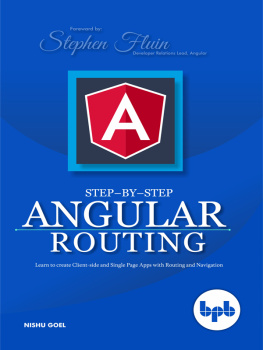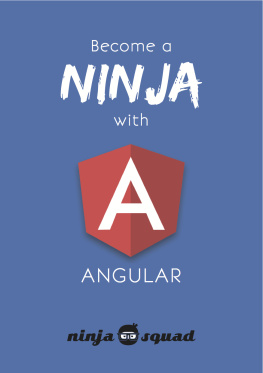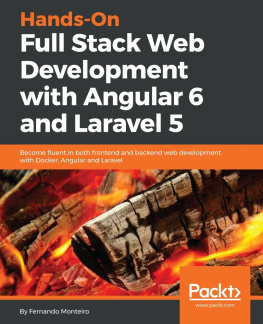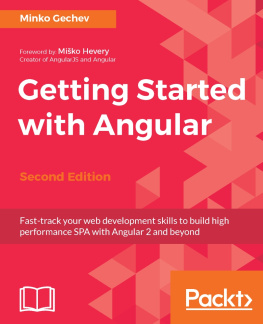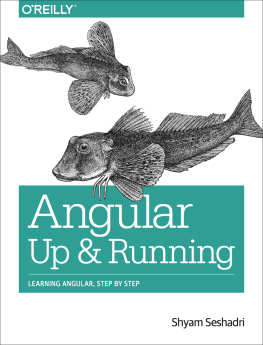Angular: Up and Running
By Shyam Seshadri
Copyright 2018 Shyam Seshadri. All rights reserved.
Printed in the United States of America.
Published by OReilly Media, Inc. , 1005 Gravenstein Highway North, Sebastopol, CA 95472.
OReilly books may be purchased for educational, business, or sales promotional use. Online editions are also available for most titles (http://oreilly.com/safari). For more information, contact our corporate/institutional sales department: 800-998-9938 or corporate@oreilly.com .
- Acquisitions Editor: Mary Treseler
- Developmental Editor: Angela Rufino
- Production Editor: Kristen Brown
- Copyeditor: Kim Cofer
- Proofreader: Jasmine Kwityn
- Indexer: Ellen Troutman-Zaig
- Interior Designer: David Futato
- Cover Designer: Ellie Volckhausen
- Illustrator: Rebecca Demarest
Revision History for the First Edition
- 2018-05-31: First release
See http://oreilly.com/catalog/errata.csp?isbn=9781491999837 for release details.
The OReilly logo is a registered trademark of OReilly Media, Inc. Angular: Up and Running, the cover image, and related trade dress are trademarks of OReilly Media, Inc.
The views expressed in this work are those of the author, and do notrepresent the publishers views. While the publisher and the author have used good faith efforts to ensure that the information and instructions contained in this work are accurate, the publisher and the author disclaim all responsibility for errors or omissions, including without limitation responsibility for damages resulting from the use of or reliance on this work. Use of the information and instructions contained in this work is at your own risk. If any code samples or other technology this work contains or describes is subject to open source licenses or the intellectual property rights of others, it is your responsibility to ensure that your use thereof complies with such licenses and/or rights.
978-1-491-99983-7
[LSI]
Introduction
Its funny that we constantly over- or underestimate the impact of certain events and projects in our lives. I seriously believed that the last project I worked on at Google, Google Feedback, would end up completely changing how the company interacted with its customers. And I believed Angular (AngularJS at the time) would just be another flash-in-the-pan, yet-another-framework that would not outlive the Feedback projects admin interface.
And in hindsight, it was exactly the other way around. While Feedback still exists and is baked into a lot of Google products, it is Angular that has gone from a tiny project used by one internal team at Angular to now being used by thousands of developers and companies worldwide. And a lot of it stems from Misko, Igor, and the entire team around it, and their unerring dedication to improving how we develop web applications.
What started off as a two-member project is now one of the largest open source communities on the web, and the framework has impacted and been a part of thousands of projects across the world. There are dozens of books, hundreds of tutorials, and thousands of articles on Angular, and Angulars adoption and support continues to grow each day.
Some of the major concepts that were ahead of their time during the first version of Angular (like data binding, separation of concerns, dependency injection, etc.) are now common features of new frameworks.
The biggest change to the AngularJS ecosystem has been the release of the new version of Angular (initially called Angular 2.0, now just called Angular). It was a drastic, non-backward-compatible change that almost divided an entire community. But with community engagement and an open, inclusive team, what could have been a disastrous step turned out to be a much needed overhaul of Angular to bring it to the new age of web development.
Truly, what makes Angular a great technology and framework is the community around itthose who contribute to the core framework, or develop plug-ins for it, as well as those who use it on a day-to-day basis.
As part of the community, I am truly excited to present this book, and contribute in my own way to what makes this community great.
Who Should Read This Book
This book is for anyone who is looking to get started with Angular (2.0 and onward), whether as a side project, as an additional tool, or for their main work. It is expected that readers are comfortable with JavaScript and HTML before starting this book, but a basic knowledge of JavaScript should be sufficient to learn Angular. Knowledge of AngularJS 1.0 is not needed or expected.
We will also use TypeScript, which is the recommended way of developing in Angular, but a preliminary knowledge is sufficient to read this book.
We will take it step by step, so relax and have fun learning with me.
Why I Wrote This Book
Angular as a framework has grown immensely, and comes with a large set of features and capabilities. With a large community behind it, it also comes with an influx of helpful content. But the help content, tutorials, and guides are either focused only on particular topics, or sporadic and not necessarily useful for someone getting started.
The aim of this book is to provide a step-by-step guide on getting started with Angular. Each concept is provided in a logical, organized fashion, building on top of the previous one. With so many moving parts and an active community, this book does not intend to cover each and every aspect, but instead focuses on the core building blocks in a detailed fashion while letting readers discover the rest on their own.
At the end of the book, you should be familiar with a majority of the Angular framework, and be able to use Angular to develop your own web applications and use it in your own projects.
A Word on Web Application Development Today
JavaScript has come a long way, to the point where it is one of the most widely used and adopted programming languages. Nowadays, its rare for web developers to have to worry about browser inconsistencies and the like, which was the primary reason for frameworks like jQuery to have existed.
Frameworks (like Angular and React) are now a very common choice for developing frontend experiences, and it is rare for anyone nowadays to decide to build a frontend application without leveraging one.
The advantages of using frameworks are manifold, from reducing boilerplate code, to providing a consistent structure and layout for developing an application to many more. The primary intent is always to reduce the time spent on cruft, and focus more on the major functionality we want to provide. And if it works across browsers (and platforms, like Android and iOS, in addition to desktop), then more power to it.
Angular (as well as other frameworks) provides this, primarily through some core fundamentals that are at the heart of the framework, including:
Powerful templating syntax driven by declarative programming
Modularity and separation of concerns
Data binding, and through it, data-driven programming
Testability and awesome testing support
Routing and navigation
And a host of other features, from server-side rendering, to the ability to write native mobile applications, and much more!
With the help of Angular, we can focus on building amazing experiences, while managing complexity and maintainability in a seamless fashion.
Navigating This Book
This book aims to walk a developer through each part of Angular, step by step. Each chapter that introduces a new concept will be immediately followed by a chapter on how we can unit test it. The book is roughly organized as follows:




